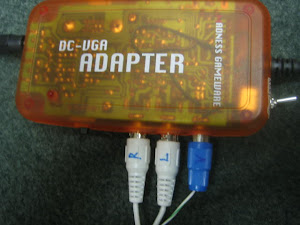The Dreamcast version of the MGCD has a similar issue to the PS2 version, of not being exactly JAMMA plug-in play. The last two edge pins on either side of the connector are mapped to joystick buttons rather than grounds (per the JAMMA spec). If these are grounded when you power up the MGCD, it will not accept any inputs from the joystick or other buttons, which is a pretty bad design flaw. So like the PS2 MGCD in Part 1, a simple adapter is needed to isolate these from the edge connector. If you actually need to use buttons 5 & 6 from both players, you can manually connect wires to the adapter and run them up to your control panel.

Above we have the MGCD, with edge adapter, mounted to a Dreamcast, and ready to be connected to any 15khz JAMMA cabinet. I should mention that the same hack used to disable the timer overlay on the PS2 version also works on the Dreamcast version. Also note this MGCD comes with an extra cable to attach a DC memory unit.
If you are like me, you relish the fact that the Dreamcast can output high resolution (31khz/VGA) natively, and I happen to have some JVS/JAMMA cabinets with tri-sync monitors. So you might think that simply using a DC-VGA adapater in place of the MGCD AV cable would work. Unfortunately its not that easy. The MGCD seems to stop working if there is no input video sync present at the MGCD AV connector. So a small hack is required to the DC-VGA box.

Shown above is my DC VGA box, which has its Composite Video Output connector modified to also be connected to composite sync, which is pin #10 on the Dreamcast AV input cable. You do not need to disconnect composite video pin #13, having both connected to the RCA jack at the same time will work fine. The blue video sync plug, shown above, is then soldered directly to the MGCD AV connector input pins (as shown below), along with Left and Right sound outputs from the VGA box.

So now I have a choice of using the MGCD amplified mono sound out of the PCB, or using the DC-VGA box's stereo headphone output if my cab has its own stereo amplifier. BTW: only the "Madness Gameware" or "DC Blaze VGA" box has headphone output and volume controls.
Lastly, you may have noticed a toggle switch on my Madness Gameware VGA box, this is a non-related hack I wrote about back in 2002 to force it into either 15khz RGB or 31khz VGA output. This is not needed for the MGCD, since you can get great 15khz RGB output by using the original MGCD AV cable.

So, below is the completed MGCD with Dreamcast VGA and stereo output connectors ready to go on a JVS/JAMMA cab.




























































